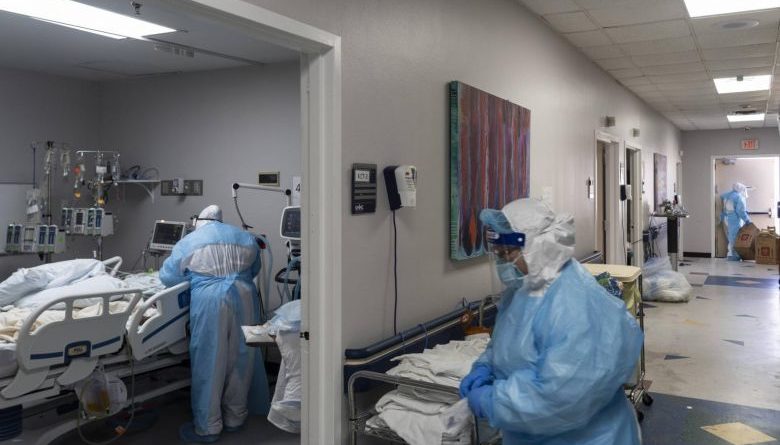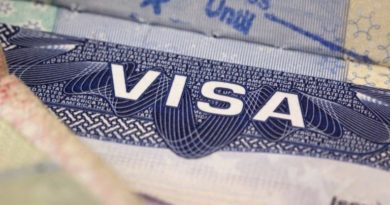COVID-19 PANDEMIC: US hospitalisations reach record high as some states tighten Covid-19 restrictions
The number of people hospitalised with the coronavirus in the US has more than doubled since September.PHOTO: AFP
.
.
.
The update-11.11.2020
Sick Earth-Plague Day 351

Coronavirus
Cases globally: 51,187,339:
Deaths: 1,268,137:
Recovered: 36,010,735.
.
.
.
.
WASHINGTON (NYTIMES, REUTERS) – Covid-19 hospitalisations in the US hit an all-time high of 61,964 on Tuesday (Nov 10), as the raging pandemic forces California and several states across the Midwest to tighten restrictions on residents.
The number of people hospitalised with the coronavirus, tallied by the Covid Tracking Project, has more than doubled since September, and now exceeds the peak reached early in the pandemic, when 59,940 hospitalised patients were reported on Apr 15.
A second peak in the summer fell just short of matching that record, with 59,718 hospitalisations on July 23.
Those spikes in April and July lasted only a few days and quickly subsided, but as winter approaches experts do not expect that this time. New cases are setting records in much of the United States, and rates of hospitalisations and deaths are following them upward.
The US surpassed 10 million known cases on Sunday, and is averaging more than 111,000 new cases a day, a record.
While the number of patients continues to climb, a shortage of nurses and other medical personnel is limiting the ability to add more hospital beds to care for them.
The critical staff shortage, especially in Western states that struggle to attract doctors and other medical workers even in the best of times, is causing growing alarm, and driving some places to take extraordinary measures.
Governor Douglas J. Burgum of North Dakota, which has the worst infection and death rates per person in the country, announced on Monday that health care workers who have tested positive but have no symptoms could continue to work in hospitals and nursing homes under certain restrictions, including that they treat only Covid-19 patients.
The Centres for Disease Control and Prevention’s guidelines allow the use of asymptomatic personnel during severe staff shortages. Burgum said his state was about two or three weeks away from facing “severe constraints” in hospital capacity.
When cases spiked in New York in April and in the South over the summer, health care professionals flew in from elsewhere to help. But now, officials describe a kind of national gridlock.
“Everywhere is either hard hit or is watching their Covid numbers go up, and are expecting to get a lot of flu patients,” said Nancy Foster, a vice-president of the American Hospital Association.
“The ability of health care professionals to pick up and leave their hometowns is very limited.” That has left hospitals jockeying to find extra staff.

In Utah, for example, Intermountain Health Care, which runs some 22 hospitals, just added another 200 nurses, including 30 imported from New York. But Dr Mark Briesacher, the company’s chief executive, said they were hard pressed to find more, a comment echoed by the heads of three other major medical groups in the state.
“We are at the tipping point,” Briesacher told a news conference on Monday. “We are beyond our normal capacity of caring for patients who are the most sick.” Along the southern tier of neighbouring Idaho, smaller hospitals have been told they can no longer rely on transfers to Utah of their most critical patients, said Toni Lawson, the vice-president for governmental relations at the 40-member Idaho Hospital Association.
Hospital transfers
Even before the pandemic, the small rural hospitals in many Western states often depended on travelling nurses. But with Wyoming, Montana, the Dakotas and Utah all facing the same problem, the going rate for an ICU nurse in the region has doubled to US$120 (S$161) an hour, more than small hospitals can afford, she said.
That leaves the small hospitals having to transfer some of their sickest patients to larger medical centres – and those beds are getting scarce, too, she said.
“I do not want to say it is a crisis yet,” Lawson said, but if the system reaches capacity, “you start making difficult decisions of who gets what care.” Although advances in coronavirus treatment have shortened hospital stays, the sheer number of patients is swamping hospitals.
Medical officials said they could try to fit in more Covid-19 patients by stopping all but the most dire emergency surgery, or by recalling retired medical workers, but ultimately the only solution is fewer infections.
“The numbers across the board are troubling, but to address the hospital side of it, you have to address the public health side of it,” said David Dillon of the Missouri Hospital Association.

New clampdowns
California and several states across the Midwest have announced new clampdowns on Tuesday to curb the spread of the disease with the onset of colder weather, straining hospitals and medical resources in some cities.
“There’s a real thing called Covid-19 fatigue, that’s understandable,” Dr Anthony Fauci, a member of the White House coronavirus task force, told CNN in an interview. “But hang in there a bit longer, do the things you need to do and we’ll be OK.”
The US government could begin vaccinating Americans as early as December if Pfizer Inc moves quickly in gaining approval of a vaccine it developed with German partner BioNTech SE, Health and Human Services Secretary Alex Azar said on Tuesday.
Pfizer said earlier this week the vaccine was more than 90 per cent effective against Covid-19, based on results from a large, late-stage trial.
Drug maker Moderna Inc MRNA.O said in late October it was on track to report early data from a late-stage trial of its experimental Covid-19 vaccine this month.
California predicts more restrictions
California has seen coronavirus hospitalisations spiral by 32 per cent over the past two weeks, Dr Mark Ghaly, the state’s health and human services secretary, told reporters at a briefing.
Intensive-care unit admissions had spiked by 30 per cent, he said.
Three California counties home to about 5.5 million people – San Diego, Sacramento and Stanislaus – must reverse their reopening plans and go back to the most restrictive category of rules as a result of the spikes, Ghaly said.
Those regulations ban indoor dining in restaurants, as well as indoor activities in gyms and religious institutions.
“We anticipate if things stay the way they are … over half of California counties will have moved into a more restrictive tier” by next week, Ghaly said.

In Minnesota, Governor Tim Walz announced new restrictions as the Midwestern state reported record-high daily Covid-19 hospitalisations, and medical systems said they may struggle to cope with the surge.
Minnesota reported 1,224 coronavirus hospitalisations on Tuesday, up from 1,084 the previous day, according to a Reuters tally.
Beginning on Friday, restaurants and bars in Minnesota must close dine-in services between 10pm and 4am and keep the number of patrons below 50 per cent of capacity. The governor’s order also includes private social gatherings, which must be limited to 10 people from three households or less.
“We’ve turned our dials, we’re going to have to turn them back a little bit today,” Walz told a briefing.
In Illinois, which recorded its highest number of daily cases on Tuesday with 12,626 new infections, Governor J.B. Pritzker told reporters a majority of the state’s regions were seeing higher hospitalisation rates than in the spring.
59,000 hospitalised
Iowa Governor Kim Reynolds also took steps to curb the disease’s spread, limiting the size of social gatherings and imposing a targeted mask-wearing requirement for certain situations.
About 59,000 Covid-19 patients were hospitalised across the United States as of Monday, the country’s highest-ever number of in-patients being treated for the disease. Daily new infections exceeded 100,000 for the sixth consecutive day.
Hospitalisations are a key metric of the pandemic because, unlike case counts, they do not rise and fall with the number of tests performed.
The United States, the world’s third-most populous country behind China and India, has logged the greatest number of cases and deaths, although other countries have higher per-capita totals.

Fauci earlier on Tuesday welcomed the Pfizer vaccine announcement but warned the winter months promised to bring more infections as people stay indoors. Health officials were reporting more infections from small gatherings, an indication the virus is being spread by asymptomatic people, he told MSNBC.
Cases were also spiking in nursing homes, said Mark Parkinson, president and chief executive of the American Health Care Association and National Centre for Assisted Living.
Nursing homes in the hard-hit Midwest had seen a 120 per cent increase in weekly Covid-19 cases since mid-September, the group said.
.


SIGN UP TO RECEIVE OUR EMAIL
.
The most important news of the day about the ASEAN Countries and the world in one email: [email protected]










